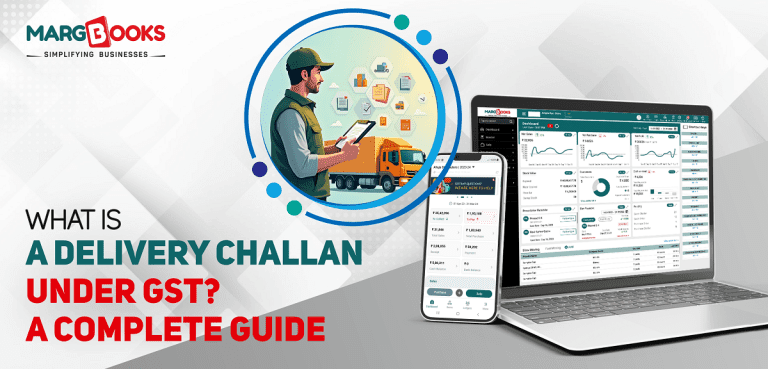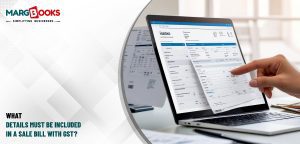When it comes to managing business operations efficiently, understanding various GST documents is crucial. One such document is the Delivery Challan Under GST, which plays an important role in transporting goods without an immediate tax invoice. In this guide, we will dive deep into what a delivery challan is, when it is required, and how businesses can efficiently manage it using billing software, accounting software, and inventory management software like MargBooks.
What is a Delivery Challan Under GST?
A Delivery Challan is a commercial document that accompanies goods during transportation when an invoice is not immediately raised. It serves as proof of delivery and contains details about the goods being transported.
As per Rule 55 of the CGST Rules, 2017, a delivery challan must be issued when goods are transported without an invoice for specific purposes. It is commonly used in business scenarios where the movement of goods does not necessarily lead to an immediate sale.
Key Features of a Delivery Challan:
- Contains details of goods such as description, quantity, and value.
- Does not include tax details like a tax invoice.
- Helps businesses track goods in transit.
- Required to comply with GST regulations in certain cases.
When is a Delivery Challan Required?
A delivery challan under GST is needed in the following situations:
- Supply of Liquid Gas – When the quantity of gas supplied is unknown at the time of dispatch.
- Job Work – When goods are sent to a job worker and will return after processing.
- Sale on Approval Basis – When goods are sent to a customer for approval, but the sale has not been confirmed.
- Exhibition or Consignment – Goods sent for exhibition or consignment without an immediate sale.
- Return of Goods – When goods are returned without an invoice.
- Transport of Goods Between Business Locations – If a company moves stock between warehouses.
- Goods Sent for Testing or Repair – Items sent for quality checks or repairs before final invoicing.
In such cases, businesses must ensure they generate a proper delivery challan to avoid any GST compliance issues.
Format of a Delivery Challan Under GST
A delivery challan under GST should include the following details:
- Title: ‘Delivery Challan’ must be clearly mentioned.
- Challan Number: A unique serial number (continuous or system-generated).
- Date of Issue: The date when the challan is generated.
- Sender & Recipient Details: Name, GSTIN, and address of both parties.
- Description of Goods: Name, quantity, and unit of goods being transported.
- HSN Code: Harmonized System Nomenclature code of the goods.
- Taxable Value: The approximate value of goods (excluding tax).
- Reason for Transportation: Mention whether the movement is for job work, return, or another purpose.
- Signature: Authorized signatory of the sender.
How to Generate a Delivery Challan Easily?
Manual creation of delivery challans can be time-consuming and prone to errors. Instead, businesses can simplify this process using billing software, accounting software, and inventory management software like MargBooks.
Benefits of Using Software for Delivery Challans:
- Auto-Generation of Challans – No need for manual entry; software auto-generates challans based on stock movement.
- Seamless GST Compliance – Ensures all mandatory fields are filled correctly.
- Easy Integration with E-Way Bill – Directly links with the e-way bill system to avoid duplication.
- Efficient Record-Keeping – Maintains a digital record of all challans for future reference.
- Error-Free Transactions – Reduces mistakes compared to manual entries.
MargBooks is one such software that helps businesses manage their billing, accounting, and inventory with ease. It automates the process of generating delivery challans and ensures compliance with GST rules.
Difference Between a Delivery Challan and a Tax Invoice
Many businesses confuse a delivery challan with a tax invoice. Below are the key differences:
- Purpose: A delivery challan is used for the transport of goods without an immediate sale, whereas a tax invoice is used for the sale of goods or services.
- GST Details: A delivery challan does not include tax details, while a tax invoice does.
- Applicability: A delivery challan applies to job work, return, exhibition, etc., whereas a tax invoice is issued when a taxable supply is made.
- Legal Document: A delivery challan serves as proof of movement, while a tax invoice is proof of sale.
A tax invoice is issued when goods are sold, while a delivery challan is used when goods are moved for purposes other than direct sales.
Steps to Ensure GST Compliance with Delivery Challans
To avoid penalties and maintain smooth operations, follow these steps:
- Use Reliable Billing Software – A GST-compliant billing system like MargBooks ensures that all documents are generated correctly.
- Ensure Proper Record-Keeping – Keep a copy of all delivery challans for audit purposes.
- Match Challans with E-Way Bills – When applicable, ensure that your delivery challan data matches your e-way bill.
- Mention Accurate Details – Double-check the goods description, quantity, and value before transportation.
- Issue a Tax Invoice Later (If Required) – If the goods are eventually sold, a tax invoice should be issued after the movement.
Conclusion
A delivery challan under GST is a crucial document for businesses that transport goods without an immediate sale. It ensures compliance with GST laws and helps in tracking inventory movement. By using advanced billing software, accounting software, and inventory management software like MargBooks, businesses can automate the process and eliminate manual errors.
With the right tools, managing delivery challans becomes effortless, ensuring that businesses remain GST-compliant while efficiently handling their logistics. If you haven’t already, consider integrating MargBooks into your operations for seamless inventory and billing management!




